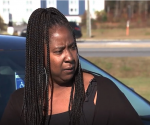Bed rails that can injure and kill the elderly remain on the market
[ad_1]
As U.S. regulators and legislators move to ban potentially deadly infant-sleep products, bed rails and bed handles that have killed hundreds of mostly elderly Americans remain on the market.
Often purchased for sick or frail older people, the side rails or metal bars are used on hospital beds and in home care with the idea of helping patients pull themselves up or to keep them from falling out of bed. But these products — which are marketed as safety devices and are sold by retailers including Amazon and Walmart as well as by medical supply stores — have shown to be anything but safe for thousands of older and disabled patients injured by them.
“There’s a lot of guilt on the part of the person who purchased it,” said Gloria Black, whose 81-year-old mother, Clara Marshall, died after her neck became caught in side rails in 2007.
Worried Marshall would slip off her mattress onto the floor, Black’s father had purchased the bed rails on the advice of nursing staff at the assisted-living facility where his wife lived in Vancouver, Washington, Black told CBS MoneyWatch. A month after her mother’s burial, the state health department contacted Black to see if she was aware of the product’s role in her mother’s death.
“It’s very common in these cases. People don’t necessarily realize a bed rail was involved,” Black said. “Once I found out, the agreement with my father was we need to do something. It led to my advocacy.”
In researching what had occurred to her mother, Black learned that others also had died of asphyxiation after their necks became entrapped in bed rails. “There was zero evidence that these products could make people safer.”
Decades of accidents
Black also learned that government entities had been aware of the danger for years.
Between 1985 and 2013, the Food and Drug Administration received reports of 901 incidents of patients caught, trapped, entangled or strangled by hospital bed rails. They included 531 deaths, 151 nonfatal injuries and 220 cases where staff needed to intervene to prevent injuries.
“Most patients were frail, elderly or disoriented,” according to the agency, which regulates hospital beds manufactured with side rails as medical devices.
U.S. Food and Drug Administration
Additionally, seven deaths associated with portable bed rails were reported to the FDA from 2005 to 2013, according to the agency.
More recent examples of incidents involving bed rails can be found by searching the FDA’s site. Although details are inconclusive, one 2016 case reported to the FDA described a patient who died and who was found with “her head lodged in the bed side rail, and the rest of her body on the floor.”
An estimated 69,000 adults were treated in U.S. hospital emergency rooms for rail-related injuries from 2003 to 2019, according to the Consumer Product Safety Commission. Among those incidents, 260 cases involved adult portable bed rails, including 247 fatalities, according to a July 2020 CPSC briefing paper.
“The question of whether the current products available on the market in 2020 substantially comply with the voluntary standard has yet to be determined,” added the agency in the report, which estimates that between 90,000 and 425,000 adult portable bedrails are sold annually.
“They are all unsafe,” one doctor says
Portable rails may be regulated either by the FDA as a medical product or by the CPSC as a consumer product, depending on the intended use.
The agencies “have received many death and injury reports related to both adult portable bed rail products and hospital bed rails,” the FDA states on its website. Most involve entrapment and falls, with deaths and serious injuries possible even when the products are properly designed, compatible with the bed and mattress, and used appropriately, the agency said.
The trouble is likely understated as bed rails are not necessarily listed as the cause of death by nursing homes and coroners, or as the cause of injury by emergency room doctors.
“They are all unsafe: Whether it’s a bed rail placed on the side of a bed to protect an adult or a child from falling out of the bed, or to help them position themselves, to help get in and out of bed, they are too dangerous,” said Dr. Michael Carome, director of health research at Public Citizen. “There is no way to design them to make them safe because entrapment can occur.”
The FDA and the CPSC did not respond to requests for comment.
U.S. Consumer Product Safety Commission
The CPSC recently announced new safety standards to effectively eliminate inclined sleepers for babies under five months old. Inclined sleepers and crib bumper pads, which are linked to numerous infant deaths from asphyxiation, would also be banned under the Safe Sleep for Babies Act passed by the House last month, and a bipartisan version has been introduced in the Senate.
But a decades-old effort to prevent similar hazards for elderly and disabled Americans has largely fizzled. Urged in a 2013 petition by Public Citizen and other advocates, including Black, to ban bed rails, the federal agencies that oversee the products have instead focused on recalls and producing voluntary standards to improve their safety.
The FDA, for instance, issued warnings about bed rails as far back as 1995, and adopted voluntary guidelines for manufacturers in 2006. The CPSC’s standard, also voluntary, took effect in 2017. It includes safety labels and warnings, as well as “instructional literature requirements intended to minimize entrapment and strangulation hazards,” according to CPSC.
The product safety panel has also overseen multiple product recalls, in April cautioning consumers against using three models of portable bed rails sold online by Walmart and other retailers due to the risk of entrapment and strangulation.
Consumer Product Safety Commission
Linked to the strangulation deaths of four elderly or disabled people, including Black’s mother, about 113,000 adult portable bed handles were recalled in 2014 so they could be outfitted with safety straps thought to address the danger.
“CPSC evaluated the bed rails and found that they can allow an individual to become entrapped between the bed rail and mattress, or within the portions of the bed rail itself, leading to asphyxia,” CPSC stated in its warning.
Tougher measures required
Some experts think government warnings and voluntary industry standards are insufficient.
“The problem with the portable rails is they really can’t be adjusted in a safe way to prevent the gap from opening up between the rail and mattress,” said Steven Miles, a retired M.D. and professor emeritus at the Center for Bioethics at the University of Minnesota, who first warned federal regulators about the rails in 1995.
“Furthermore, the FDA presumes that one rail is different from another, when all the rails are fundamentally alike,” added Miles in dismissing the notion that standards or warnings would curtail the inherent dangers.
Because deaths and injuries caused by bed rails involve mostly elderly people, Miles believes the danger is overlooked.
“These are people who are old and expected to die anyway,” he said. “Is there any other population where we can hide 500 deaths?”
[ad_2]
Source link













